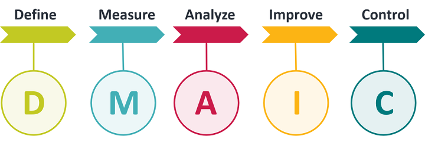Gestion / Articles
La méthode DMAIC : en quoi consiste-t-elle, à quoi sert-elle et comment l’utiliser
Réduire le gaspillage, résoudre les problèmes et améliorer les processus. Découvrez la méthode DMAIC et apprenez comment la mettre en pratique.

 10 minutes de lecture
10 minutes de lecture
2023-03-30 17:00:02
À la fin des années 80, la National Geographic – l’une des marques les plus respectées de l’histoire avec des publications régulières depuis le XIXe siècle – rencontrait des difficultés pour cibler de nouveaux publics. L’équipe exécutive avait trouvé la solution : pénétrer le monde de la télévision câblée et créer une nouvelle chaîne dénommée National Geographic TV. Mais lorsque le projet a été présenté au conseil d’administration, la réaction n’a pas été celle espérée. Les membres du conseil ne savaient quel était le problème que la solution devait résoudre.
Avec le recul, la confusion était compréhensible. L’équipe directive n’a pas détaillé l’étendue des défis que représentait la création d’une nouvelle chaîne de télévision et n’a pas non plus expliqué le lien entre cette innovation et la prospection de nouveaux abonnés payants. Au lieu de chercher l’approbation de la nouvelle chaîne, ils auraient dû débattre de la meilleure manière de rendre la marque plus attirante pour une audience plus jeune ou, plus largement, de prospecter les clients qui leur manquaient, au vu de la concurrence croissante. Au final, le projet n’a pas été mené à bien mais, quelques années plus tard, deux nouveaux concurrents sont arrivés sur le marché. Les chaînes Discovery Channel et Histoire, toutes deux au concept similaire, ont fini par matérialiser le concept et ainsi atteindre des audiences record pendant plusieurs années.
De tels cas sont très nombreux, qui viennent rejoindre la longue liste des entreprises qui ont laissé passer des opportunités historiques. Et, même si chaque cas est unique, il ne fait aucun doute que les stratégies et les outils de résolution de problèmes peuvent aider à une meilleure prise de décisions commerciales et à relever les défis les plus délicats. Ces outils, dont la méthode DMAIC est l’un des exemples les plus populaires, visent à identifier les variables importantes d’une situation difficile et d’envisager les solutions possibles. Grâce à une approche structurée en 5 étapes de résolution des problèmes complexes, la méthode DMAIC a déjà été appliquée à une large gamme d’industries et de secteurs. Découvrez en quoi elle consiste et comment l’appliquer.
Qu’est-ce que la méthode DMAIC ?
Afin de trouver les meilleures réponses, il est nécessaire de se poser les bonnes questions – ce que l’on appelle communément « l’encadrement » du problème. Souvent négligée, cette étape définit la trajectoire à suivre pour gérer les différentes alternatives possibles. Il s’agit de l’un des principaux objectifs de la méthode DMAIC, l’un des principaux outils de la Lean Six Sigma, et une première étape essentielle pour deux raisons : elle peut révéler de nouvelles solutions possibles et évite de perdre du temps, de l’argent et des efforts avec des idées incomplètes.
Ce méthode a pour principal objectif de structurer la résolution de problèmes en se focalisant sur l’amélioration permanente, au travers de 5 étapes séquentielles bien distinctes : Définir (Define), Mesurer (Measure), Analyser (Analyse), Améliorer (Improve) et Contrôler (Control). Elle peut être mise en œuvre de manière autonome ou en intégrant d’autres initiatives de gestion de la qualité.

Source : Qualidados
Chaque étape prévoit spécifiquement le but à atteindre et la manière, au travers d’un raisonnement logique permettant d’analyser tous les problèmes et d’intervenir directement à la source.
À quoi sert la méthode DMAIC ?
La méthode DMAIC est un outil d’amélioration permanente spécialement prévu pour identifier les problèmes dans les processus et aider à leur résolution. En premier lieu, la méthode DMAIC aide à obtenir une vision réelle et objective d’une certaine situation ou d’un problème, ainsi qu’à analyser les variables contribuant à sa survenance.
Ensuite, la DMAIC permet d’élaborer un plan d’intervention basé sur des données. Il s’agit d’un autre point fort de cette méthode, qui consacre trois de ses cinq étapes à la planification. L’astuce consiste précisément à se concentrer plus sur cette phase, afin de diminuer le taux d’effort de la mise en œuvre et la probabilité d’échec.
Des méthodes comme la DMAIC sont particulièrement importantes si l’on considère qu’une formulation incorrecte ou incomplète du problème représente l’un des principaux obstacles à sa résolution. L’utilisation d’outils de résolution structurée de problèmes oblige toute l’équipe à franchir une série d’étapes. Elles facilitent également les échanges, en évitant les multiples interprétations quant au problème à résoudre et à la solution espérée.
Comment mettre en œuvre la méthode DMAIC, pas à pas
La méthode DMAIC propose 5 étapes distinctes et séquentielles, facilement applicables à tout type de problème et à toute organisation.
1. Définir (Define)
Dans cette première étape, il est nécessaire de définir le problème ou l’opportunité. Il est donc également important d’aborder la situation actuelle et son rapport avec la situation souhaitée. Cela inclut d’identifier les restrictions ou limites pouvant faire obstacle au résultat visé, ainsi que d’établir l’existence des ressources suffisantes pour atteindre l’objectif.
2. Mesurer (Measure)
La deuxième étape consiste à évaluer la situation actuelle, d’un point de vue quantitatif. Par conséquent, il est essentiel de définir des mesures illustrant correctement le problème et d’autres mettant en évidence des opportunités d’amélioration. Cette étape permettra d’établir une comparaison fondée, une fois les améliorations mises en œuvre. Il convient ensuite d’identifier les causes éventuelles, en dissociant celles générant un impact plus conséquent sur les résultats. Une bonne manière de procéder est d’avoir recours au diagramme d’Ishikawa, également connu sous le nom de « l’arête de poisson », qui permet d’analyser les causes d’un certain effet.
3. Analyser (Analyze)
Dans cette phase, vous devrez analyser les données collectées à l’étape précédente afin d’en identifier les principales causes. Vous pourrez avoir recours à des techniques statistiques pour analyser les tendances et déterminer les principales causes des faibles performances, qui peuvent être éliminées du processus. À ce stade, l’analyse FMEA peut s’avérer utile pour anticiper les failles.
4. Améliorer (Improve)
C’est lors de cette étape que sont mises en œuvre les solutions précédemment définies. Il est important que les spécifications soient claires, afin d’assurer leur persistance et dûment documentées, si elles doivent éventuellement être répliquées ultérieurement. La méthodologie 5S et la méthode Kaizen sont quelques-uns des outils les plus utilisés dans cette phase, afin d’introduire rapidement des changements dans un projet.
5. Contrôler (Control)
Enfin, comme son nom l’indique, cette étape consiste à surveiller et contrôler les résultats, afin de vérifier qu’ils remplissent les objectifs, l’essentiel étant de veiller à ce que le problème ne se reproduise pas ou, s’il se produit à nouveau, garantir une réponse immédiate et efficace.
La MultiWasher, la technologie d’amélioration de la qualité du lavage industriel
L’utilisation de la méthode DMAIC est l’une des nombreuses manières d’investir dans la gestion de la qualité. L’amélioration permanente passe également par des technologies permettant d’augmenter les performances des processus.
Dans le cas précis du lavage industriel, les entreprises peuvent hygiéniser tout type d’ustensile grâce à la MultiWasher. Cette machine de dernière génération offre des performances sans précédent, grâce à la technologie la plus récente afin d’assurer un lavage autonome, efficace et efficient. Assistez à une démonstration de la MultiWasher et découvrez comment améliorer la qualité de vos processus d’hygiénisation.
Tu pourrais aimer

Gestion / Articles
TQM : quand l’erreur est un atout
Le TQM ou Total Quality Management est la méthode où l’erreur est à la fois amie et ennemie. Découvrez ce que cela signifie et comment cela peut...
Publié dans 2022-11-24

Gestion / Articles
Comment élaborer un plan d’action efficace
Pour assurer la réussite d’un projet, un plan est nécessaire. Découvrez comment cet outil peut aider à transformer votre rêve en réalité.
Publié dans 2023-01-19

Gestion / Articles
L’analyse FMEA : en quoi consiste-t-elle, à quoi sert-elle et comment la mettre en œuvre
L’analyse FMEA permet aux entreprises de détecter les failles critiques avant qu’elles ne surviennent. Découvrez en quoi elle consiste, quels son...
Publié dans 2022-04-21






















 Portugal
Portugal United Kingdom
United Kingdom United States
United States France
France Spain
Spain Germany
Germany Romania
Romania Italy
Italy Czech Republic
Czech Republic Finland
Finland Hungary
Hungary Slovakia
Slovakia Greece
Greece Lithuania
Lithuania South Korea
South Korea Russia
Russia Saudi Arabia
Saudi Arabia Poland
Poland Brasil
Brasil Hebrew
Hebrew